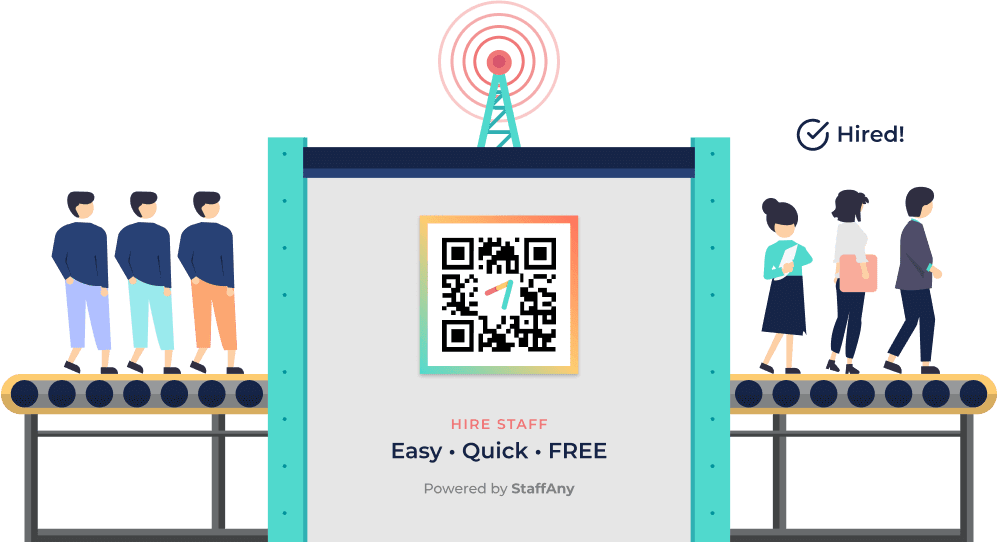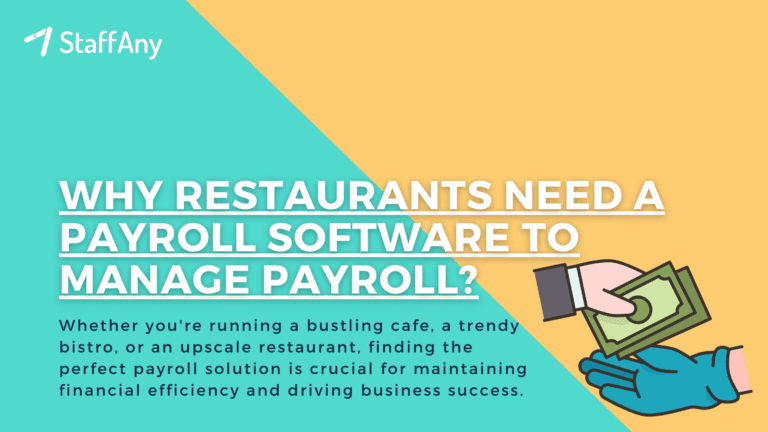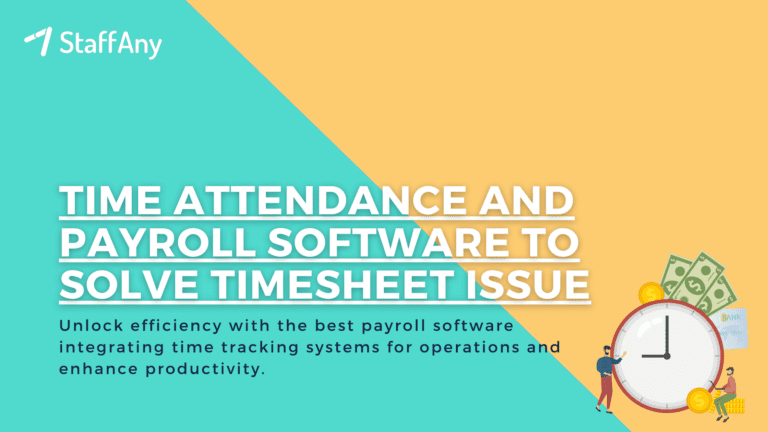Manpower planning is not just for companies, but also crucial for F&B businesses to operate efficiently. As a business owner, manager, or decision maker, understanding the basics of manpower planning can help you effectively plan and manage your workforce. This article will provide a comprehensive overview of the concept and steps for its practical application in the F&B industry.
What Is Manpower Planning?

Manpower planning, also known as human resource planning, manpower management, or workforce planning, is a crucial aspect of human resource management that enables organisations to effectively plan and allocate their workforce requirements in the future needs.
With manpower planning process, businesses can organise their staffing levels, ensuring they have the right number of employees ready to start work at the right time. For example, during a holiday period such as Hari Raya Eid al-Fitr, when there may be fewer employees available, manpower planning can help businesses prepare for this and avoid understaffing.
Overall, manpower planning is a critical aspect of effective workforce management that allows organisations to align their human resources with their overall business goals and objectives.
Read more: Graveyard Shift: Meaning, Advantages, and Disadvantages
The Importance of Manpower Planning in F&B Businesses

Manpower planning, also known as workforce planning, is crucial for the success and sustainability of F&B (Food and Beverage) businesses. Here are several reasons highlighting the importance of manpower planning in this industry:
1. Optimizing Staffing Levels
Manpower planning enables F&B businesses to determine the optimal number of staff required to meet operational needs. This helps avoid overstaffing, which can lead to unnecessary labor costs, or understaffing, which can result in poor customer service and operational inefficiencies.
2. Cost Control and Budgeting
Effective manpower planning assists in controlling labor costs, which often constitute a significant portion of the operating expenses in F&B businesses. By aligning staffing levels with business demands, organizations can better manage labor budgets and allocate resources efficiently.
3. Enhancing Customer Service
Properly trained and adequately staffed teams contribute to better customer service. Manpower planning ensures that there are enough skilled and knowledgeable staff members available to handle peak times, provide quality service, and create positive dining experiences for customers.
4. Meeting Seasonal Demand
F&B businesses often experience fluctuations in demand based on seasons, holidays, or special events. Manpower planning helps businesses anticipate these fluctuations and adjust staffing levels accordingly, ensuring that they are adequately prepared to handle increased or decreased customer traffic.
5. Reducing Employee Turnover
Manpower planning involves anticipating future staffing needs and identifying skill gaps. This proactive approach allows businesses to invest in training and development programs, which can contribute to employee satisfaction and retention. Lower turnover rates reduce the costs and disruptions associated with recruiting and onboarding new staff.
6. Ensuring Compliance with Labor Laws
Manpower planning includes considerations for labor regulations, working hours, and employee rights. Staying compliant with labor laws is crucial for avoiding legal issues and maintaining a positive employer reputation.
7. Promoting Workforce Diversity and Inclusion
Manpower planning allows businesses to assess the diversity of their workforce and make intentional efforts to promote inclusivity. A diverse team can bring a variety of perspectives and skills, contributing to innovation and better meeting the needs of a diverse customer base.
8. Enhancing Employee Productivity
By having the right number of staff with the necessary skills, businesses can enhance overall employee productivity. A well-staffed and motivated team is more likely to efficiently handle tasks, leading to smoother operations and improved overall performance.
9. Strategic Business Growth
Proper manpower planning is an integral part of strategic business growth. It allows businesses to align their workforce with expansion plans, ensuring that the necessary human resources are in place to support new locations, increased production, or expanded services.
In summary, manpower planning is essential for F&B businesses to manage manpower resources effectively, provide excellent customer service, control costs, and adapt to the dynamic nature of the industry. It plays a critical role in the overall success and sustainability of these businesses.
Read more: Top 3 Trends Driving the F&B Industry in Malaysia
Manpower Planning Objectives
Here are the objectives of manpower management that will contribute to future industry developments, and to the productivity of existing human resources:
1. Ensure that There’ll be Correct Staffing Levels
The first objective of manpower planning is to forecast the need of staffing levels, and to work with managers to make sure that each department is staffed properly. The human resource department must make plans in company’s employment needs to make sure that they won’t be understaffed whenever they need new employees.
2. Good Succession Planning
It is proven that utilising the existing workforce is cheaper than hiring new employees to fulfill the role within the company. Companies must compensate for the recruiting costs, training programmes, and the cost of low productivity because the new employee is settling into the new job.
In practice, manpower planning is making sure that the current manpower inventory is able to be circulated within the company to prevent looking for new recruits. In this process, companies must track the skill set of each employee to be able to move them.
3. Assessing the Future Demand
With constantly changing business requirements, future manpower planning involve the process of anticipating the future skills required for hiring qualified candidates. Those candidates are meant to fulfill upcoming future projects. The HR Department must participate in every aspect of business planning in recruiting for new job duties that the company hasn’t experienced with in the past.
4. Optimisation of Efficiency and Productivity
A company must utilise its employees efficiently to increase productivity and to maintain employee morale. Workforce efficiency can be maximised by creating different work shifts, opening part-time shifts, offering overtime to fulfill the increased production needs, and training current employees with a good training program.
Offering shift options and giving employees the tools that will help them with their job are ways in maintaining employee morale.
Read more: Rotational Shift Meaning and Its Benefits for F&B Businesses
Steps in Manpower Planning Process

Manpower planning is a vital process for ensuring an efficient workforce. Here are five steps to follow to ensure effective manpower planning:
1. Identify Your Business Goals and Objectives
Clearly define your business goals and objectives, as they will help you determine the right staff for each position and align the work that needs to be done with these goals so they can succeed.
2. Analyse Current Workforce Data
Collect data on the current workforce, including employee turnover rates, absenteeism, and skill levels. This information can help identify any existing or potential issues that need to be addressed.
3. Assess Future Supply and Demand
Also known as forecasting, this step is crucial in identifying your market and potential changes on the horizon. Forecasting helps organisations prepare for increases or decreases in workforce needs, such as onboarding many employees after securing a major catering event, or even adjusting staffing levels due to market contraction.
4. Develop and Implement Strategy
Based on the analysis of current and future workforce needs, develop and implement strategies such as recruiting and training new employees, offering incentives for current employees to stay, or outsourcing specific tasks. Make sure that the necessary resources are in place to execute these strategies.
5. Monitor and Evaluate The Result
Manpower planning is an ongoing process and regular monitoring and evaluation are necessary to ensure that strategies are working as intended. Track key performance indicators such as employee turnover rates to see if strategies have had an impact. Continuously evaluate and improve the process for better future results.
Read more: Guideline for Overtime in Malaysia Labour Law
Examples of Manpower Planning in F&B
Here are examples of how manpower planning can be applied in the F&B industry:
1. Staffing Levels
An F&B business may use manpower planning to determine the number of employees needed to staff the restaurant during peak hours, based on historical sales data. This can help ensure that customers receive prompt service and minimise wait times.
2. Seasonal Planning
Many F&B businesses experience changes in demand during different seasons. Manpower planning can help businesses prepare for these changes by determining the number of employees needed during peak seasons and adjusting staffing levels during slower seasons.
3. Special Events
F&B businesses that host special events, such as weddings or corporate events, may use manpower planning to determine the number of employees needed to staff the event and ensure that all aspects of the event run smoothly.
4. Skill-based planning
Manpower planning in the F&B industry can also be used to identify the specific skills and qualifications required for different roles within the business, such as chefs, servers, and bartenders. This can help ensure that the right employees are in place to meet the needs of the business and provide high-quality service to customers.
5. Preparing for the future
F&B businesses can use forecasting and trend analysis to predict potential changes in the market, such as the rise of online delivery platforms or the trend towards plant-based diets. Manpower planning can help businesses prepare for these changes by making adjustments to staffing levels, skills, and other factors to ensure they are well-positioned to adapt to these changes.
Find the Right Candidate with Applicant Tracking System

Do you now understand the importance of manpower planning and looking to find the right talent effectively for your establishment? Try to use Applicant Tracking Software like StaffAny. This system makes it easy for you to manage job posting and find the right candidate in a timely manner.
Here are some benefits of ATS Software you will gain:
1. Quickly Share Job Openings with QR Code & URL
You can effortlessly connect with specific job seekers across various platforms using StaffAny’s auto-generated QR code and URL. By utilizing multiple job boards feature, you can identify the best talent for your business.
This effective recruiting software will assist business owners in enhancing their operations with a new hiring strategy.
2. Customize Your Job Application Form
Customize your application form with screening questions to obtain the relevant information from job seekers.
Boost your job postings by incorporating detailed job descriptions, enabling potential candidates to grasp the requirements of the position. Furthermore, you can elevate your hiring process by leveraging StaffAny’s applicant tracking system.
3. Streamline Your Hiring Process with StaffAny
As a business owner, you can effortlessly review and manage candidates, along with tracking job applications, through our all-in-one applicant tracking system. All qualified candidates from your posted job listings will be sorted automatically based on their performance.
Manage candidate engagement efficiently, and initiate interview scheduling to discover top talent for your business. Start utilizing StaffAny to streamline your hiring process today!
Furthermore, StaffAny’s workforce management software dedicated to F&B and the shift work industry can help you plan and manage your manpower effectively. With smart timesheets designed to embrace changes on the ground, and an automated scheduling system to help you plan schedules across multiple outlets with better cost control & faster speed, our all-in-one software helps you save cost, spend less time and get smarter as you grow.
There’s more! Interested to learn what else StaffAny can do for your manpower planning in F&B? Reach out to us now!











